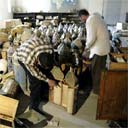 When, back in mid-April, the news first arrived of the looting at the Iraqi National Museum in Baghdad, words hardly failed anyone. No fewer than 170,000 items had, it was universally reported, been stolen or destroyed, representing a large proportion of Iraq's tangible culture. And it had all happened as some US troops stood by and watched, and others had guarded the oil ministry.
When, back in mid-April, the news first arrived of the looting at the Iraqi National Museum in Baghdad, words hardly failed anyone. No fewer than 170,000 items had, it was universally reported, been stolen or destroyed, representing a large proportion of Iraq's tangible culture. And it had all happened as some US troops stood by and watched, and others had guarded the oil ministry.
...100,000-plus priceless items looted either under the very noses of the Yanks, or by the Yanks themselves. And the only problem with it is that it's nonsense. It isn't true. It's made up. It's bollocks.
Not all of it, of course. There was some looting and damage to a small number of galleries and storerooms, and that is grievous enough. But over the past six weeks it has gradually become clear that most of the objects which had been on display in the museum galleries were removed before the war. Some of the most valuable went into bank vaults, where they were discovered last week. Eight thousand more have been found in 179 boxes hidden "in a secret vault". And several of the larger and most remarked items seem to have been spirited away long before the Americans arrived in Baghdad.
...
"There was a mistake," he said. "Someone asked us what is the number of pieces in the whole collection. We said over 170,000, and they took that as the number lost. Reporters came in and saw empty shelves and reached the conclusion that all was gone. But before the war we evacuated all of the small pieces and emptied the showcases except for fragile or heavy material that was difficult to move."
...
Cruikshank also tackled George directly on events leading up to the looting. The Americans had said that the museum was a substantial point of Iraqi resistance, and this explained their reticence in occupying it. Not true, said George, a few militia-men had fired from the grounds and that was all. This, as Cruikshank heavily implied, was a lie. Not only were there firing positions in the grounds, but at the back of the museum there was a room that seemed to have been used as a military command post. And it was hardly credible that senior staff at the museum would not have known that. Cruikshank's closing thought was to wonder whether the museum's senior staff - all Ba'ath party appointees - could safely be left in post.
Furious, I conclude two things from all this. The first is the credulousness of many western academics and others who cannot conceive that a plausible and intelligent fellow-professional might have been an apparatchiks of a fascist regime and a propagandist for his own past. The second is that - these days - you cannot say anything too bad about the Yanks and not be believed.
» Lost from the Baghdad museum: truth
This discussion has been closed. No more comments may be added.